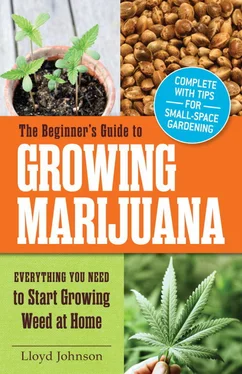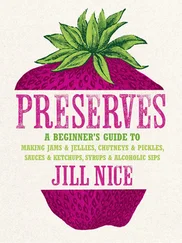Also, another factor to consider about your climate is many states have punitive laws about growing cannabis; you are well advised to educate yourself as to the statutes in your locality.
If you are lucky, you live in a medical cannabis state and can obtain legal permissions, at least on the state level. Otherwise, with very few exceptions, almost every state’s laws consider growing or manufacturing recreational cannabis (even small amounts for your own personal use) to be a felony.
Only you can assess the risk you are willing to take, but checking the laws in your state might be helpful in understanding and evaluating that risk. Go to the website of the National Organization for the Reform of Marijuana Laws (NORML) at www.norml.org and select your state to see an up-to-date list of laws and penalties. Very few people realize how serious law enforcement can be about what is, after all, only a plant.
Medical Cannabis States
Do you live in a state that currently has medical cannabis laws? Although cannabis remains illegal and a Schedule I drug under United States federal law, many states have passed medical marijuana laws and that number is increasing on a yearly basis.
In almost all of these states, patients are required to produce their own cannabis, or to designate an individual to produce it for them. Some states have dispensary programs, but mostly patients are on their own and, like most recreational users, must turn to the black market if they lack a grower.
Another real benefit of living in a medical cannabis state is your increased access to different strains and to helpful knowledge. Medical cannabis patients can network openly, and, depending upon their state’s particular statute, can usually freely exchange medicine and plants.
If you are lucky enough to live in a state that has a medical marijuana law, it is imperative, as a prospective grower, to do your research. It is extremely foolish to ignore statutes that, if followed, will provide you with very real protection from state and local law enforcement agencies.
City, Suburb, Rural?
City and suburban growers are mostly forced to grow indoors; otherwise, they will usually raise plants for cannabis thieves, commonly known as “rippers.” This name is particularly apt, as not only are they ripping you off, but also the smash and grab tactics commonly used involve literally ripping the plants apart or from the earth.
The last thing you want is to have strangers targeting your home and your plants. With that warning in mind, however, a smaller amount of cannabis plants can be intermixed with a regular garden and will frequently escape detection. Aerial searchers are also more prone to look in rural areas for bigger grows, while the suburban or city grower is more likely to be overlooked by taller buildings, or to have someone smell their plants. Rooftop grows are also becoming more common; they are usually far more secure than growing on a deck or in a backyard.
Rural grow sites have the advantage for outdoor growing. Many grows are discovered by passersby smelling the cannabis and doing a little investigating; acreage and proper placement of the crop eliminate this danger. Intermixing the cannabis with a summer vegetable garden will help keep the plants from aerial spotting. In the country, deer and livestock predations make high fencing common for noncannabis gardens, so casual observers would have no reason to suspect a cannabis crop is also being grown.
How Much Do You Want to Grow?
The second item to consider is how much you want to grow. Usually, the quick answer is: as much as possible! There are two kinds of answers to this question, as it can be taken in two different ways.
Grow Like a Gardener
One, how much do you want to grow? Do you already garden and think, “I can grow a great tomato plant, why would cannabis be any more difficult?” Do you look at friends’ cannabis gardens and feel attracted to the plants themselves? If you answered yes, then you actually want to grow cannabis.
If you already feel like growing will be an added chore or boring labor, it is possible that you just do not have a feel for the enjoyment of gardening, no matter what you are growing. Or you might feel intimidated as to how difficult it might be. Don’t be! Try growing a smallish amount and confirm that your real interest is in being a consumer, not a producer, of cannabis. Or, despite your initial reservations, you might find yourself captivated and fascinated and become a lifelong grower.
Grow for Supply
The other interpretation is how much do you want to grow? Is your purpose in growing to supply yourself or a friend or relative with medical cannabis? You need to sit down and figure out how many ounces a month are medically needed. Bear in mind that tinctures and medibles (edibles containing marijuana) use far more than ingestion by smoking.
As a first-time grower, make your calculations based on a yield of four to six ounces per plant. Once you know what you are doing, it is not unreasonable to expect a pound to a pound and a half per plant yields, but it is always better to be pleasantly surprised by a higher yield than to come up short.
If you plan to grow indoors at home, the sheer space limitations of your house may make your garden-size decision for you. It is not advisable to crowd indoor plants, as it will substantially reduce yields. Crowding, particularly during the flowering stage, also leads to problems with mold and mites. The space you use for your inside garden needs to be away from general family activities, and somewhere you can lock without appearing suspicious. Even if you are growing legally, there is no reason to (and many reasons not to) let anyone not directly concerned know about your grow.
You also have to think about home security. Placing the plants inside your home can keep them safer from thieves, but the downside is that inside plants put you at greater risk for a personal confrontation with a criminal or criminals.
You must also factor in the legal restrictions on plant numbers that pertain to your particular state. Also, some states limit the number of patients for whom a grower can legally grow. This number is important to know and abide by, as unpleasant interactions with law enforcement can literally ruin your life.
Keeping the Plants Healthy
Bear in mind the space requirements that large, healthy cannabis plants will need, especially outdoors. With a little effort on your part, these plants will grow to be at least six feet in height for sativas and, depending on your climate, possibly considerably more. Indicas tend to be shorter and bushier. Planting too closely can lead to poor air circulation and mold, so figure to give each female plant at least six feet of space in diameter. Smaller plantings of low-growing herbs can be scattered in between; this makes it much harder to discern cannabis from the air.
The plants will need good sunlight, and lots of it. The plants will need water, and in quantities far greater than you will want to carry; there should be convenient access to good water. The plants will also need protection, mainly from other humans. Ideally, the grow site will be where you can easily monitor day and night; this usually means near your house, unless you plan to sleep outside for the last month before harvest.
The other thing to consider in location is the actual distance from your house to the crop. This can be a factor if you are robbed and file a claim with your homeowner’s insurance. It is worth checking your policy, as it has become more common for insurance to pay damages to legal medical cannabis growers when their plants are stolen. Sometimes there are restrictions on how far insured items can be from your actual house: Something on the back forty, even though still on your property, probably would not be covered.
Читать дальше












